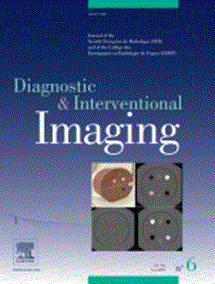Relaxing the PI-RADS dominant sequence rule improves the characterization of high-grade prostate cancer on multiparametric MRI
IF 8.1
2区 医学
Q1 RADIOLOGY, NUCLEAR MEDICINE & MEDICAL IMAGING
引用次数: 0
Abstract
Purpose
The Prostate Imaging-Reporting and Data System 2.0 (PI-RADSv2.0) and 2.1 (PI-RADSv2.1) scores are deduced from the pulse sequence categories using the "dominant sequence" scoring rule. The purpose of this study was to develop and evaluate a new scoring rule that makes better use of non-dominant pulse sequence findings.
Material and methods
The new scoring rule was developed using a single-center database of 1627 patients who underwent prostate multiparametric MRI and prostate biopsy. The combinations of PI-RADSv2.0 pulse sequence categories observed at sextant level were ranked based on their rate of high-grade (grade group ≥ 2) prostate cancer and assigned to one of the five levels of the new score. Then, a hidden evaluation dataset of 240 MRI lesions to which 21 readers of varying experience had assigned PI-RADSv2.1 pulse sequence categories was used. For each reader, the PI-RADSv2.1 score of the lesions (PI-RADSv2.1 dominant sequence rule) and the new score (scoring rule defined in the development cohort) were computed. The scores were compared using areas under the curve (AUC), sensitivities, specificities, reproducibility, and clinical utility.
Results
Across all readers, the mean AUC of the new score (0.78; 95 % confidence interval [CI]: 0.73–0.83) was significantly greater than that of the PI-RADSv2.1 score (0.76; 95 % CI: 0.71–0.81; P < 0.01). The new score showed lower sensitivity, higher specificity and better inter-reader agreement in all reader experience subgroups. Across all readers, for a ≥ 3 dichotomization, it provided a higher net benefit than the PIRADSv2.1 score for risk thresholds > 0.15.
Conclusion
The new scoring rule outperformed the dominant sequence rule in characterizing high-grade prostate cancer regardless of reader experience.
放宽PI-RADS显性序列规则可改善多参数MRI对高级别前列腺癌的表征。
目的:前列腺成像报告和数据系统2.0 (PI-RADSv2.0)和2.1 (PI-RADSv2.1)评分是使用“优势序列”评分规则从脉冲序列类别中推断出来的。本研究的目的是开发和评估一种新的评分规则,以更好地利用非显性脉冲序列的发现。材料和方法:新的评分规则是使用1627例接受前列腺多参数MRI和前列腺活检的患者的单中心数据库制定的。在六分仪水平观察到的PI-RADSv2.0脉冲序列类别组合根据其高级别(分级组≥2)前列腺癌的发生率进行排名,并分配到新评分的五个级别之一。然后,使用一个包含240个MRI病变的隐藏评估数据集,其中21个不同经验的读者已经分配了PI-RADSv2.1脉冲序列类别。对于每个读者,计算病变的PI-RADSv2.1评分(PI-RADSv2.1显性序列规则)和新评分(发展队列中定义的评分规则)。使用曲线下面积(AUC)、敏感性、特异性、可重复性和临床实用性对评分进行比较。结果:在所有读者中,新评分的平均AUC (0.78;95%置信区间[CI]: 0.73-0.83)显著大于PI-RADSv2.1评分(0.76;95% ci: 0.71-0.81;P < 0.01)。在所有读者体验亚组中,新评分显示出较低的敏感性,较高的特异性和更好的读者间一致性。在所有读者中,对于≥3的二分类,它提供了高于风险阈值PIRADSv2.1评分> 0.15的净收益。结论:无论读者经验如何,新的评分规则在评价高级别前列腺癌方面优于显性序列规则。
本文章由计算机程序翻译,如有差异,请以英文原文为准。
求助全文
约1分钟内获得全文
求助全文
来源期刊

Diagnostic and Interventional Imaging
Medicine-Radiology, Nuclear Medicine and Imaging
CiteScore
8.50
自引率
29.10%
发文量
126
审稿时长
11 days
期刊介绍:
Diagnostic and Interventional Imaging accepts publications originating from any part of the world based only on their scientific merit. The Journal focuses on illustrated articles with great iconographic topics and aims at aiding sharpening clinical decision-making skills as well as following high research topics. All articles are published in English.
Diagnostic and Interventional Imaging publishes editorials, technical notes, letters, original and review articles on abdominal, breast, cancer, cardiac, emergency, forensic medicine, head and neck, musculoskeletal, gastrointestinal, genitourinary, interventional, obstetric, pediatric, thoracic and vascular imaging, neuroradiology, nuclear medicine, as well as contrast material, computer developments, health policies and practice, and medical physics relevant to imaging.
 求助内容:
求助内容: 应助结果提醒方式:
应助结果提醒方式:


